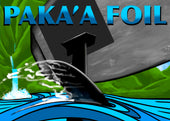High Aspect Versus Medium Aspect Front Foil Wings
The aspect ratio of a foil wing is that ratio of its span (measuring wing tip to wing tip) to its average chord (front to back distance). A low aspect wing would be similar to a fighter aircraft (designed for maneuverability) and a high aspect wing would be similar to a glider, designed to stay aloft.
Every foil size and shape has a slightly different stall speed or lift speed, just like an airplane wing. Short thick foils have a lift speed around 8mph or lower. Wide and thin wings (high aspect) have a higher lift speed, so you will need more board speed to pop up on foil.
For foiling, high aspect wings have great glide and are more efficient at pumping, but they are harder to turn and recover from a turn. Because high aspect wings are typically thinner than medium aspect wings (and a shorter chord), they have a higher top-end speed, but also have a higher low end stall speed or lift speed.
Medium aspect wings have better turning and recovery, but less glide and require more force to pump. Medium aspect wings are generally thicker giving lift at slower speeds (a longer chord helps too), but have a lower high-end speed than high aspect. Medium aspect wing are much easier to learn on than high aspect, and are the best blend of attributes to get started.
Mathematically, Aspect Ratio (AR) equals span X span / area. High aspect wings have AR around 8-10, medium have about 4-6, low aspect wings have AR of 3 or less.
Low aspect wings are mostly first generation wings and are not recommended.





